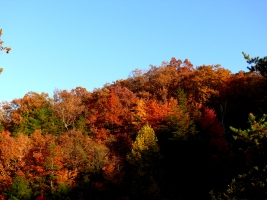 *These foxgloves are growing in a garden in Colonial Williamsburg.
*These foxgloves are growing in a garden in Colonial Williamsburg.
“…where the deer’s swift leap Startles the wild bee from the foxglove bell.” ~John Keats
Foxglove, also known as Digitalis: I’ve grown this beautiful flower/herb and used to have a spectacular stand of foxglove but they died out one winter and I’ve had the dickens of a time getting new plants established. Because foxglove is a biennial, it has to grow one season and survive the winter, the tricky part, and then resurrects the following spring and blooms in late spring/early summer. If you’re fortunate the plants reseed and perpetuate themselves. If not, you must begin again. But it’s well worth growing. I suspect our soil may be too heavy and needs to be further lightened with compost, so I did just that and planted a new variety of foxglove a week ago. So far, so good.
 From A Modern Herbal: Foxglove: POISON!
From A Modern Herbal: Foxglove: POISON!
“Other names: Witches’ Gloves. Dead Men’s Bells. Fairy’s Glove. Gloves of Our Lady. Bloody Fingers. Virgin’s Glove. Fairy Caps. Folk’s Glove. Fairy Thimbles. (Norwegian) Revbielde. (German) Fingerhut.
Part Used: Leaves.
Habitat: The Common Foxglove of the woods (Digitalis purpurea), perhaps the handsomest of our indigenous plants, is widely distributed throughout Europe and is common as a wild-flower in Great Britain, growing freely in woods and lanes, particularly in South Devon, ranging from Cornwall and Kent to Orkney, but not occurring in Shetland, or in some of the eastern counties of England.
Needing little soil, it is found often in the crevices of granite walls, as well as in dry hilly pastures, rocky places and by roadsides. Seedling Foxgloves spring up rapidly from recently-turned earth. Turner (1548), says that it grows round rabbit holes freely. The plant will flourish best in well drained loose soil, preferably of siliceous origin, with some slight shade. The plants growing in sunny situations possess the active qualities of the herb in a much greater degree than those shaded by trees, and it has been proved that those grown on a hot, sunny bank, protected by a wood, give the best results.
 Description: The normal life of a Foxglove plant is two seasons, but sometimes the roots, which are formed of numerous, long, thick fibers, persist and throw up flowers for several seasons… (*Not here, always.)
Description: The normal life of a Foxglove plant is two seasons, but sometimes the roots, which are formed of numerous, long, thick fibers, persist and throw up flowers for several seasons… (*Not here, always.)
They bloom in the early summer, though the time of flowering differs much, according to the locality.
The flowers are bell-shaped and tubular, 1 1/2 to 2 1/2 inches long, flattened above, inflated beneath, crimson outside above and paler beneath, the lower lip furnished with long hairs inside and marked with numerous dark crimson spots, each surrounded with a white border. The shade of the flowers varies much, especially under cultivation, sometimes the corollas being found perfectly white.
The Foxglove is a favourite flower of the honey-bee, and is entirely developed by the visits of this insect. Going from flower to flower up the spike, he rubs pollen thus from one blossom on to the cleft stigma of another blossom, and thus the flower is fertilized and seeds are able to be produced. The life of each flower, from the time the bud opens till the time it slips off its corolla, is about six days. An almost incredible number of seeds are produced, a single Foxglove plant providing from one to two million seeds to ensure its propagation. (*But it has to survive long enough to bloom, I must add.)
 It is noteworthy that although the flower is such a favourite with bees and is much visited by other smaller insects, who may be seen taking refuge from cold and wet in its drooping blossoms on chilly evenings, yet no animals will browse upon the plant, perhaps instinctively recognizing its poisonous character.
It is noteworthy that although the flower is such a favourite with bees and is much visited by other smaller insects, who may be seen taking refuge from cold and wet in its drooping blossoms on chilly evenings, yet no animals will browse upon the plant, perhaps instinctively recognizing its poisonous character.
The Foxglove derives its common name from the shape of the flowers resembling the finger of a glove. It was originally Folksglove – the glove of the ‘good folk’ or fairies, whose favourite haunts were supposed to be in the deep hollows and woody dells, where the Foxglove delights to grow. Folksglove is one of its oldest names, and is mentioned in a list of plants in the time of Edward III. Its Norwegian name, Revbielde (Foxbell), is the only foreign one that alludes to the Fox, though there is a northern legend that bad fairies gave these blossoms to the fox that he might put them on his toes to soften his tread when he prowled among the roosts.
The earliest known form of the word is the Anglo-Saxon foxes glofa (the glove of the fox).
 The mottlings of the blossoms of the Foxglove and the Cowslip, like the spots on butterfly wings and on the tails of peacocks and pheasants, were said to mark where the elves had placed their fingers, and one legend ran that the marks on the Foxglove were a warning sign of the baneful juices secreted by the plant, which in Ireland gain it the popular name of ‘Dead Man’s Thimbles.’ In Scotland, it forms the badge of the Farquharsons, as the Thistle does of the Stuarts. The German name Fingerhut (thimble) suggested to Leonhard Fuchs (the well-known German herbalist of the sixteenth century, after whom the Fuchsia has been named) the employment of the Latin adjective Digitalis (from Digitabulum, a thimble) as a designation for the plant, which, as he remarked, up to the time when he thus named it, in 1542, had had no name in either Greek or Latin.
The mottlings of the blossoms of the Foxglove and the Cowslip, like the spots on butterfly wings and on the tails of peacocks and pheasants, were said to mark where the elves had placed their fingers, and one legend ran that the marks on the Foxglove were a warning sign of the baneful juices secreted by the plant, which in Ireland gain it the popular name of ‘Dead Man’s Thimbles.’ In Scotland, it forms the badge of the Farquharsons, as the Thistle does of the Stuarts. The German name Fingerhut (thimble) suggested to Leonhard Fuchs (the well-known German herbalist of the sixteenth century, after whom the Fuchsia has been named) the employment of the Latin adjective Digitalis (from Digitabulum, a thimble) as a designation for the plant, which, as he remarked, up to the time when he thus named it, in 1542, had had no name in either Greek or Latin.
The Foxglove was employed by the old herbalists for various purposes in medicine, most of them wholly without reference to those valuable properties which render it useful as a remedy in the hands of modern physicians. Gerard recommends it to those ‘who have fallen from high places,’ and Parkinson speaks highly of the bruised herb or of its expressed juice for scrofulous swellings, when applied outwardly in the form of an ointment, and the bruised leaves for cleansing for old sores and ulcers. Dodoens (1554) prescribed it boiled in wine as an expectorant, and it seems to have been in frequent use in cases in which the practitioners of the present day would consider it highly dangerous…
Strangely enough, the Foxglove, so handsome and striking in our landscape, is not mentioned by Shakespeare, or by any of the old English poets.
(*I found this strange indeed, considering their lore and beauty.)
 The earliest known descriptions of it are those given about the middle of the sixteenth century by Fuchs and Tragus in their Herbals. According to an old manuscript, the Welsh physicians of the thirteenth century appear to have frequently made use of it in the preparation of external medicines. Gerard and Parkinson advocate its use for a number of complaints, and later Salmon, in the New London Dispensatory, praised the plant. It was introduced into the London Pharmacopoeia in 1650, though it did not come into frequent use until a century later, and was first brought prominently under the notice of the medical profession by Dr. W. Withering, who in his Acount of the Foxglove, 1785, gave details of upwards of 200 cases, chiefly dropsical, in which it was used.”
The earliest known descriptions of it are those given about the middle of the sixteenth century by Fuchs and Tragus in their Herbals. According to an old manuscript, the Welsh physicians of the thirteenth century appear to have frequently made use of it in the preparation of external medicines. Gerard and Parkinson advocate its use for a number of complaints, and later Salmon, in the New London Dispensatory, praised the plant. It was introduced into the London Pharmacopoeia in 1650, though it did not come into frequent use until a century later, and was first brought prominently under the notice of the medical profession by Dr. W. Withering, who in his Acount of the Foxglove, 1785, gave details of upwards of 200 cases, chiefly dropsical, in which it was used.”
 Of course the highly esteemed Author Agatha Christie used foxglove in one of her mysteries. From the AGATHA CHRISTIE SITE: “THE HERB OF DEATH: SIR AMBROSE’S DINNER PARTY IS NOT GOING TO PLAN. FOXGLOVE LEAVES, PICKED EARLIER THAT DAY, HAVE MADE EVERYONE ILL AND LEFT THE UNFORTUNATE SYLVIA DEAD…”
Of course the highly esteemed Author Agatha Christie used foxglove in one of her mysteries. From the AGATHA CHRISTIE SITE: “THE HERB OF DEATH: SIR AMBROSE’S DINNER PARTY IS NOT GOING TO PLAN. FOXGLOVE LEAVES, PICKED EARLIER THAT DAY, HAVE MADE EVERYONE ILL AND LEFT THE UNFORTUNATE SYLVIA DEAD…”
Christie went back to one of her favourite murder methods in this story originally published in 1930 in Storyteller. It is included in The Thirteen Problems.”

























































This was very interesting, Beth.
LikeLike
Thanks Gerri. I love doing it.
LikeLike
I love your site. So much variety, wonderful pictures. artwork and tempting books. I could spend hours here. It’s like a library, museum, and garden rolled into one
LikeLike
Thanks so much. Very kind of you. I love doing it all.
LikeLike
So interesting. They sure are beautiful.
Sue B
LikeLike
Yes, they are and thanks. I hope these new ones I’ve planted in what should be the perfect spot will thrive.
LikeLike
Pingback: Chinese Foxglove (Rehmannia glutinosa) | Find Me A Cure
Pingback: Spring Pheasant’s Eye(Adonis vernalis ) | Find Me A Cure
Pingback: Digitalis ambigua(Perennial Foxglove) | Find Me A Cure